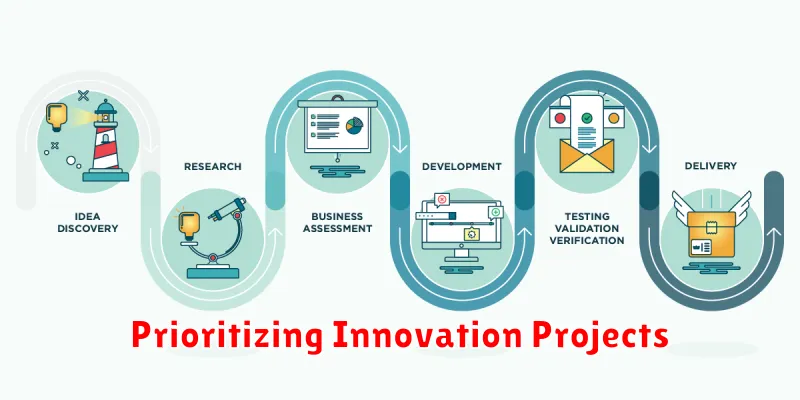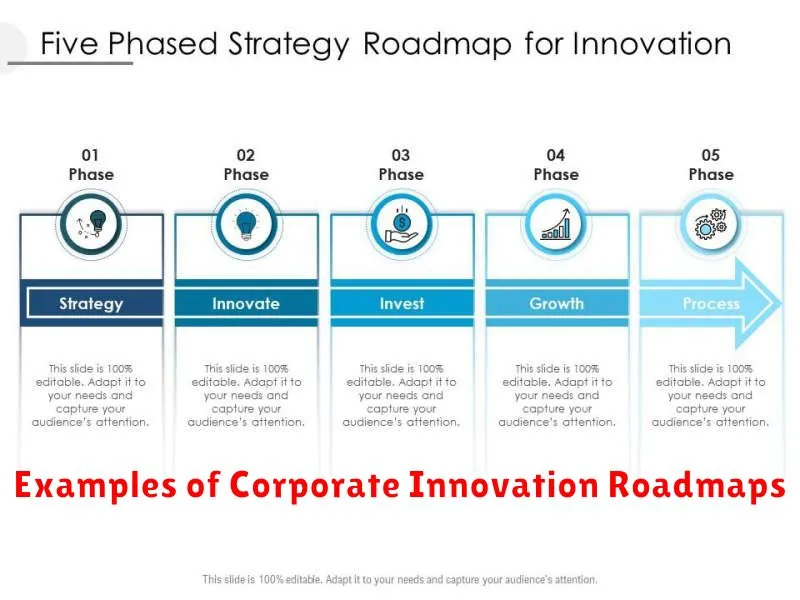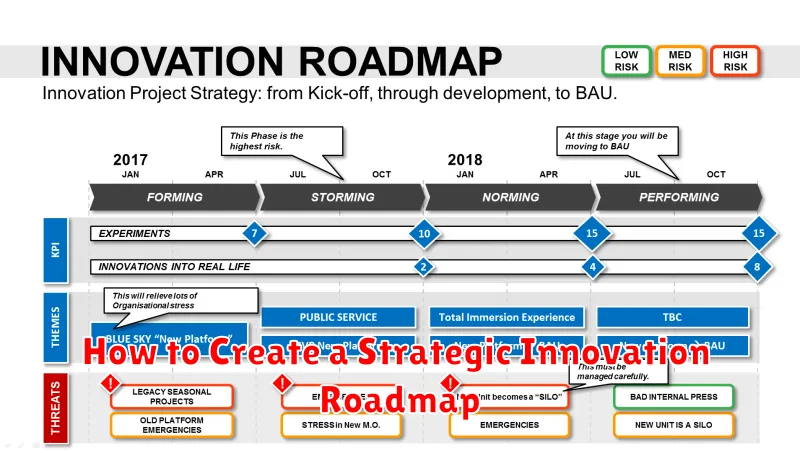In today’s rapidly evolving business landscape, innovation is no longer a luxury but a necessity for survival. Creating a strategic innovation roadmap is crucial for organizations seeking to navigate disruption, capitalize on emerging opportunities, and achieve sustainable growth. This roadmap serves as a guiding document, outlining the organization’s innovation strategy, prioritizing key initiatives, and allocating resources effectively to achieve strategic objectives. A well-defined roadmap ensures alignment between innovation efforts and overall business goals, maximizing the impact and return on investment.
This article will provide a comprehensive guide on how to create a strategic innovation roadmap that drives tangible results. We will explore the key components of a successful roadmap, including defining your innovation vision, conducting a thorough market analysis, identifying key innovation areas, and establishing clear metrics for measuring progress. By following the steps outlined in this article, organizations can effectively manage their innovation pipeline, foster a culture of innovation, and ultimately achieve long-term success in the face of constant change.
What Is a Strategic Innovation Roadmap?
A strategic innovation roadmap is a visual representation that outlines an organization’s innovation strategy over a specific period. It provides a clear and concise overview of planned innovation initiatives, aligning them with overall business objectives. It serves as a communication tool, fostering alignment and transparency across teams and stakeholders.
The roadmap typically includes key elements such as timeframes, resources allocated, expected outcomes, and key performance indicators (KPIs). It highlights the prioritization of innovation projects and helps track progress towards achieving strategic goals. It is a dynamic document, subject to change and adaptation as market conditions and business needs evolve.
Linking Innovation with Company Vision
A critical first step in developing a strategic innovation roadmap is aligning innovation initiatives with the overarching company vision. This ensures that innovation efforts contribute directly to the long-term strategic goals of the organization. Without this crucial link, innovation can become fragmented and fail to deliver meaningful impact.
Clearly defining the company vision provides a north star for innovation activities. It helps focus resources, prioritize projects, and make informed decisions about which innovative ideas to pursue. By connecting innovation to the vision, organizations can avoid pursuing novelties that, while interesting, don’t contribute to the bigger picture.
Identifying Emerging Technologies
A crucial step in creating a strategic innovation roadmap involves identifying emerging technologies relevant to your industry. This requires proactive research and analysis to understand technological advancements that could potentially disrupt or significantly impact your business.
Effective methods for identifying these technologies include monitoring industry publications, attending conferences, and engaging with technology experts. Analyzing patent filings and research papers can also provide valuable insights into developing trends.
Prioritize technologies based on their potential impact and feasibility. Consider the maturity level of the technology and its alignment with your overall business strategy.
Prioritizing Innovation Projects

Once brainstormed, innovation projects require careful prioritization. This ensures that resources are allocated effectively to the most impactful initiatives.
Several factors play a crucial role in prioritization. Potential impact on key business metrics is a primary consideration. Projects anticipated to deliver significant improvements in revenue growth, cost reduction, or market share should be ranked higher.
Feasibility is another important aspect. Consider the resources required, the technical complexity, and the regulatory landscape. Projects with higher feasibility are generally preferred.
Alignment with strategic objectives is essential. Ensure the project contributes to the overall business strategy and supports long-term goals. Finally, time to market is a factor, with projects offering quicker returns sometimes prioritized to generate momentum and early learning.
Creating Innovation KPIs
Establishing Key Performance Indicators (KPIs) is crucial for measuring the success of your innovation roadmap. Measurable KPIs provide tangible data to track progress and demonstrate the value of innovation initiatives.
Select KPIs aligned with your overall strategic goals. Some examples include: revenue generated from new products, number of patents filed, customer satisfaction with new offerings, and time-to-market for new innovations.
Regularly monitor and analyze these KPIs to understand the effectiveness of your innovation efforts. This data-driven approach enables informed decision-making and adjustments to your roadmap as needed.
Resource Allocation for Innovation
Resource allocation is a critical aspect of a successful innovation roadmap. It involves strategically distributing available resources—including funding, personnel, and time—to support innovation initiatives.
Effective resource allocation requires a clear understanding of innovation goals and priorities. Align resources with projects that offer the greatest potential for impact and alignment with overall business strategy.
Consider a portfolio approach to resource allocation, diversifying investments across different types of innovation projects, ranging from incremental improvements to more radical, disruptive innovations. This balances risk and maximizes the potential for returns.
Regularly review and adjust resource allocation based on performance, market changes, and emerging opportunities. Flexibility is key to adapting to the dynamic nature of innovation.
Involving Stakeholders in Innovation
Stakeholder involvement is crucial for successful innovation. Identifying key stakeholders early in the process ensures alignment and buy-in. This includes individuals or groups impacted by or who can influence the innovation initiative.
Effective communication is key. Regularly update stakeholders on progress, challenges, and successes. Actively solicit feedback and incorporate it into the roadmap. This fosters a sense of ownership and increases the likelihood of adoption.
Different stakeholders have varying levels of influence and interest. Prioritize engagement based on these factors. Executive sponsorship, for example, is critical for securing resources and driving organizational support.
Integrating Feedback for Iteration
Gathering and integrating feedback is crucial for iterative development of your innovation roadmap. Feedback should be collected from diverse stakeholders, including customers, internal teams, and industry experts.
This feedback informs necessary iterations and adjustments. Analyze the feedback to identify areas for improvement, potential pivots, and validation of your strategic direction. Regular feedback loops ensure your roadmap remains aligned with market demands and organizational goals.
Use the feedback to refine priorities, adjust timelines, and reallocate resources as needed. This iterative process allows for flexibility and responsiveness to change, maximizing the chances of successful innovation.
Avoiding Innovation Fatigue
Innovation fatigue arises when teams are constantly pushed to innovate without a clear strategic direction or sufficient resources. This can lead to burnout, decreased morale, and ultimately, less effective innovation efforts.
To avoid this, a strategic roadmap is crucial. It provides a framework for prioritizing initiatives, allocating resources effectively, and pacing innovation efforts. This structured approach prevents teams from feeling overwhelmed and allows them to focus on high-impact projects.
Regularly reviewing and adjusting the roadmap also helps maintain its relevance and prevents teams from pursuing outdated objectives. This iterative process ensures that innovation efforts remain aligned with overall business goals and market dynamics.
Examples of Corporate Innovation Roadmaps

While specific roadmaps are confidential, we can explore generalized examples based on common innovation goals. A product innovation roadmap might focus on phased releases of new features, culminating in a fully redesigned platform over several years. Key milestones might include alpha/beta testing, customer feedback integration, and market launch dates.
A roadmap for process innovation could outline the transition to agile methodologies within an organization. This might involve training programs, pilot projects within specific teams, and ultimately enterprise-wide adoption. Metrics like development cycle time and project completion rates would track progress.
Finally, a roadmap for business model innovation might focus on shifting from a product-based to a subscription-based model. This would involve market research, pricing strategy development, and changes to customer acquisition and retention processes.

